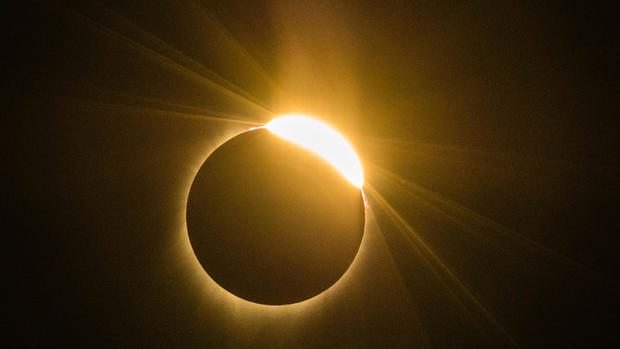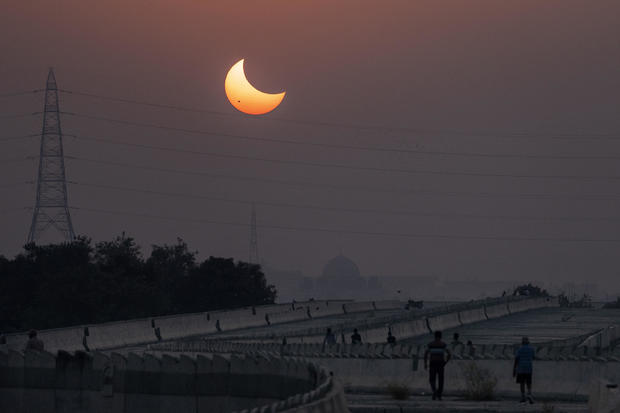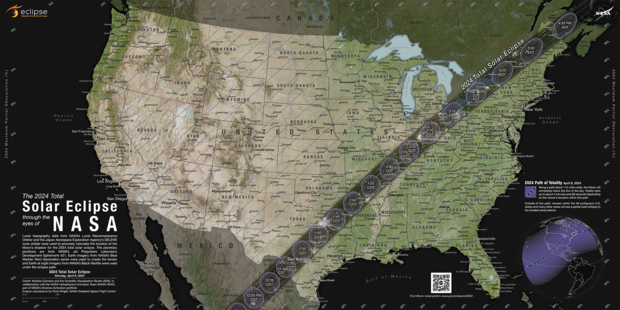
Why do total solar eclipses happen? Learn what will cause today’s celestial show.
What is a total solar eclipse? The science explained
03:27
A total solar eclipse takes shape today, April 8, when an overlap between the sun and the moon is expected to darken daylight skies over parts of North America and ask awestruck Earthlings to briefly reckon with their place in the universe. It will mark the United States’ first total solar eclipse since August 2017, although experts say this upcoming astral event could prove to be even more impressive than the last.
Here’s what to know about total solar eclipses and why they occur.
What exactly is a solar eclipse?
Eclipses of all types are caused by an alignment in space between the sun, moon and Earth. Their precise choreography results in one celestial body obscuring another, and, depending on whether the moon is positioned on the side of Earth nearest the sun or farthest from it, the moon either casts its shadow onto Earth or vice versa. During a lunar eclipse, like the one that appeared over much of the Western hemisphere in late March, all three align with Earth sandwiched in between. That sometimes allows people to watch as a shadow of the planet, backlit by the sun’s rays, moves across the moon’s surface.
Total eclipses are less common.
“It’s based on the distance from the Earth to the moon, the Earth’s orbit and, of course, the position of the sun in the sky from Earth,” said Kirk. “When all of those align, when that recipe gets to be just right, you get a total solar eclipse.”
They are especially striking to witness from Earth, something scientists chalk up to a spectacular cosmic coincidence. The sun’s diameter — the length from one end to the other — is about 400 times as large as the moon’s, and its position in space is about 400 times farther than the moon’s from Earth. From the vantage point of the planet, that ratio causes the moon and sun to look as though they are similar sizes. It can make for dramatic solar eclipses, since the moon can block out all or most of the light.
Dazzling solar eclipse photos that won’t fry your eyes 37 photos
Solar eclipses can only occur during a new moon, a milestone phase of the lunar cycle. New moons happen roughly once a month, when the moon’s orbit around Earth and Earth’s orbit around the sun intersect, with the moon gliding between the star and the planet. A similar intersection happens during a full moon, the new moon’s polar opposite. On that end of the cycle, Earth winds up in the middle instead.
Like the planet, the moon has its own sort of night and day, determined by which side of the moon faces the sun at different points in its orbit. As sunlight reflects off of half of the surface of the moon, people gazing upward see its bright, sun-facing side as moonlight.
None of the moon’s sunny side faces Earth during a new moon, which is why it looks like a dark disc covering the sun during a solar eclipse. But solar eclipses do not happen each month when the new moon does.
Although the moon does pass by the sun at regular intervals, the perfect lineup necessary for a solar eclipse is often missed. The moon’s orbit around Earth is tilted compared with Earth’s around the sun. So, when their orbits cross paths during a new moon, the intersection usually happens at an angle. The angle of just about five degrees is enough to throw off the alignment, so the new moon typically passes slightly above or slightly below the slice of light beamed from the sun onto Earth, rather than passing through it. The moon’s tilted orbit is also why full moons happen monthly but lunar eclipses do not.
What exactly happens during a solar eclipse?
As the new moon glides squarely between Earth and the sun, the sunlight still shining around it from behind projects a shadow over a portion of the planet. The natural course of the moon’s orbit traces a path along the surface of Earth, which is moving, too, as it continues to track its own orbit and spins on its axis at the same time. The path then becomes a traveling shadow, called the path of totality, where within its bounds the shadow is experienced on the ground as a total solar eclipse.
“By observing the eclipse shadow pass over you, you’re actually observing the moon’s orbit in human-scale real-time,” said Kirk. “When you see the eclipse shadow racing across the land as you go into totality, and you’re in it for a minute and you see it leaving just as fast, that is literally the orbit of the moon that you’re watching.”
Total solar eclipse sweeps across South America
03:04
The moon is closer to Earth now than it was during the total solar eclipse that dazzled millions of Americans in 2017, so today’s spectacle will have a much wider path of totality. That presents a unique opportunity for many across the country to witness a total solar eclipse, perhaps for the first time. In the contiguous United States, there will not be another chance for 20 years.
Today’s eclipse will see the moon temporarily blot out the sun in skies over a vast stretch of North America, moving from the Pacific Coast of central Mexico to the southwestern U.S., the Midwest, the Northeast and New England before tapering off in far-eastern Canada. Millions of people are flocking to places inside the path of totality, which includes cities like Dallas and Buffalo, for the show.
As the eclipse passes overhead, people watching should see afternoon light fade to resemble something like dusk or dawn. But anyone who decides to look up, even through a camera lens, needs to wear specialized protective glasses.
Weather permitting, observers in the path of totality may also be able to see wisps of the sun’s outermost atmosphere, called corona. They could potentially see a coronal mass ejection, too, which is essentially an eruption of solar material from that outer layer. Unlike the total solar eclipse in 2017, this one comes in the midst of an especially active and energetic period for the sun.
What is different about the cause of a partial solar eclipse?
People just outside the path of totality today may witness a partial solar eclipse, which happens when the moon passes between the sun and the planet without flawless alignment. Skywatchers inside the path will likely see partial eclipses before and after totality. From Earth, the moon appears to cover only part of the sun during a partial solar eclipse, at times creating the crescent shape more often associated with moonlight.
Altaf Qadri / AP
Partial and total are not the only categories of eclipse. Annular is another iteration, where the cosmic recipe for a total solar eclipse unfolds but the moon is at, or close to, the farthest point from Earth in its elliptical orbit. As it did with the annular eclipse that slipped past the U.S. last October, that extra distance causes the moon to appear smaller against the backdrop of the sun during an eclipse, like a black spot surrounded by a fiery ring. Eclipses can also shift in some situations between an annular presentation and totality.
What determines the timing of a solar eclipse?
Today’s solar eclipse starts over the South Pacific Ocean, according to NASA, and the phenomenon is first expected to arrive on land in coastal Mexico at around 11:07 a.m. PDT. Totality will linger longest near the beginning of the eclipse’s path, over an area about 25 minutes northwest of the city of Torreón. There, for up to 4 minutes and 28 seconds, the sun will all but disappear behind the dark veil of the moon.
Earth’s rotation guides the path and timing of an eclipse as much as the moon’s orbit. Whichever spot on the planet’s surface finds itself exactly aligned with the moon when the moon aligns with the sun is where the eclipse “begins.” In this case, that spot is somewhere in the South Pacific. But the moon’s position changes in orbit while the planet turns as the day goes on, and their calibration with the sun eventually falls out of alignment. The eclipse “ends” at the spot on Earth’s surface where alignment is intact for the last time.
NASA’s Scientific Visualization Studio
How long totality lasts in any given place is based on the curvature of the Earth, and the distance between its surface and the moon during a solar eclipse.
“The peak eclipse is where the moon is closest to the Earth’s surface and the most aligned with the sun,” said Kirk. “So, as that alignment gets off from the ideal peak, and you move around on the Earth’s surface because the Earth is round, that curvature brings you out of perfect alignment just a little bit. That means the length of time that you get that perfect alignment between the Earth, sun and moon to get totality is just a little bit shorter, and a little bit shorter.”
After today’s eclipse leaves Mexico, totality will touch parts of Texas, Oklahoma, Arkansas, Missouri, Illinois, Kentucky, Indiana, Ohio, Pennsylvania, New York, Vermont, New Hampshire and Maine, as well as limited areas in Tennessee and Michigan along the way. Once the eclipse passes through the U.S., it is forecast to enter Canada in Southern Ontario before moving on to Quebec, New Brunswick, Prince Edward Island and, finally, Cape Breton. It will exit continental North America on Newfoundland’s Atlantic Coast at 5:16 p.m. in the local time zone.
NASA/Scientific Visualization Studio/Michala Garrison; eclipse calculations by Ernie Wright, NASA Goddard Space Flight Center
The amount of time spent in darkness at each location within the path of totality is shorter than the last. But areas all along the eclipse’s route will still experience it for long enough to notice, with scientists estimating that even portions of Canada at the far end of it will witness totality for up to 3 minutes and 21 seconds.
For comparison, the longest period of totality observed during the 2017 solar eclipse was only 2 minutes and 42 seconds, near Carbondale, Illinois. Plus, NASA has estimated that 99% of people in the U.S. will experience the next solar eclipse to some degree — either partially or totally — no matter where they live. That includes parts of Alaska and Hawaii.
More
More
Source: cbsnews.com


